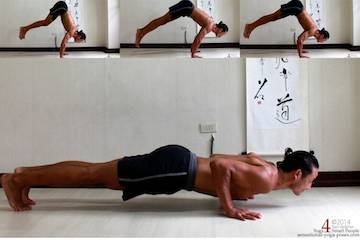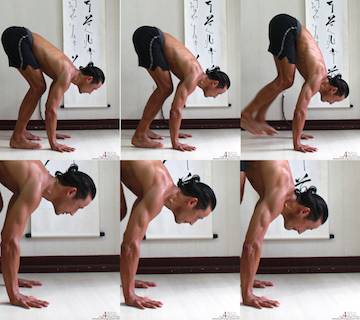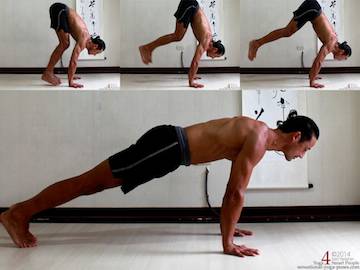Shoulder Awareness Exercises for Ashtanga Jump Backs
(Learning to Jump Back Lightly)
David Keil of yoganatomy published an article about the challenges and requirements of learning to do handstand.
One of the key points that he mentions is the need to keep the shoulders in front of the wrists while doing handstand.
I've personally found this shoulder positioning is helpful both while jumping up into handstand, and depending on body positioning, also while holding handstand.
This same shoulder control and shoulder awareness is needed to do jump backs "lightly" during sun salutations.
The following are some of the exercises that I've used to teach the required awareness before doing a full sun salute.
This same awareness can then be applied while jumping up into handstand.
Ashtanga Jump Back Shoulder Preparation Exercise 1
The first exercise starts in cat pose.
Spread the shoulder blades to lift the ribcage. Press the finger tips into the floor. Then shift the upper body forwards so that the shoulders move ahead of the wrists. Then return to the start.
The top two pictures show the shoulders relaxed and then shoulder blades spread (using serratus anterior.)
The bottom two pictures show me moving my shoulders ahead of the wrists. Try moving forwards and backwards slowly and see if you can feel the change in relationship between shoulders and wrists.
Repeat a few times moving gradually further forwards each time.
The shoulder blade spreading action is to activate the serratus anterior muscle.
After a rest try the same exercise with the knees lifted to add a little bit more weight to the arms. Remember to press the finger tips into the floor and spread the shoulder blades.
You could also try the same exercise in plank pose.
Sliding Forwards Into Chaturanga Dandasana
Because when doing an ashtanga jump back you end up in chaturanga dandasana position you can practice more or less the same exercise with elbows bent.
Then to move into full chaturanga, start in childs pose, shift your weight forwards with elbows bent, then straighten the knees.
The reason for starting in childs pose and then moving forwards is to get used to the idea of moving the shoulders forwards relative to the hands... with the elbows bent.
For extra points try to create a spreading action on the inner edges of the shoulder blades. The shoulder blades will naturally move towards each other in chaturanga dandasana because the elbows are bent besides the waist, but try to resist this action so that the serratus anterior muscle on both sides is active.
Jumping Back from a Standing Position.
Next stand with knees bent and hands on the floor. With Shoulder blades spread (protracted) and fingers active, lean your weight into your hands and shift your body and shoulders a little bit forwards, then shift back. Start with your hands ahead of your feet.
Next as you shift your weight forwards onto your hands hop your feet up. After your feet come down shift weight back onto your feet.
Notice the angle of my arms as I lean forwards and hop my feet. The second row of pictures is a close up of the first row.
First my shoulders are over my hands, then I lean my shoulders forwards. Then I jump while keeping my shoulders forwards.
Repeat this a few times.
Then as you hop try to move your feet back while keeping shoulders forwards.
Repeat this a few times working at moving your feet back further each time. Reset the feet after landing (walk or hop them forwards or walk your hands back to a position just in front of the feet.)
Jumping Back to Plank Pose
After some practice see if you can jump back into plank pose. Ideally, if you are keeping your shoulders forwards your feet will land a little more lightly on the ground since you are working at keeping your weight forwards.
Jumping Back to Plank Pose. Notice in the top two pictures to the left how I'm keeping my hips over my hands.
Ashtanga Jump Back to Chaturanga Dandasana
Next you can work at bending the elbows prior to your feet touching the floor.
Continue to work at keeping the shoulders ahead of the wrists (which may actually be a little bit easier on the wrists once you start bending your elbows.)
Jumping back to Chaturanga Dandasana.
In the top right picture especially, notice how my hips are over my hands.
Feel Your Hands While Jumping Back
If you are sensitive enough, focus on feeling your hands as you jump back and keep your weight over your hands for as long as possible.
This same trick, both that of feeling your hands, and that of keeping your shoulders forwards can be used to help make working towards handstand a little bit easier.
As for actually jumping up into handstand, next time you try it whether with both legs or whether scissor kicking, start with your shoulders ahead of your wrists. Remember to keep the shoulder blades spread and the fingers active. Keep your shoulders ahead of your wrists as you jump or kick up.
You may have to vary how far your shoulders are forwards depending your the position and shape of the rest of your body. (But so that you know the right position for your shoulders, feel your hands!)
For more on balance check out Balance Basics.
Published: 2014 06 04







